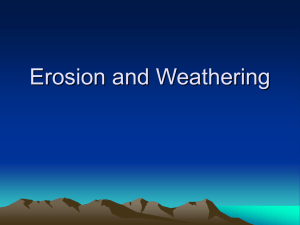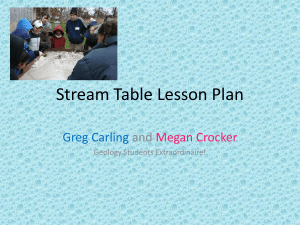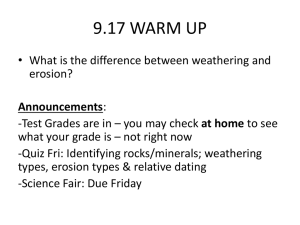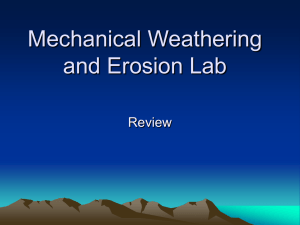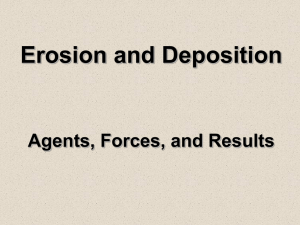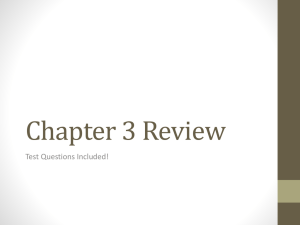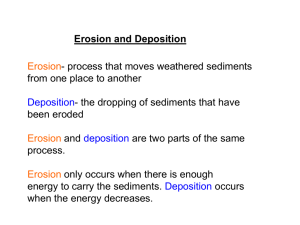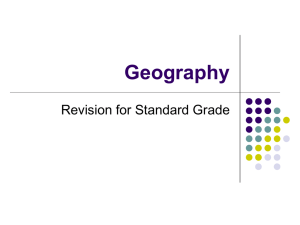Earth`s Surface Chapter 3
advertisement
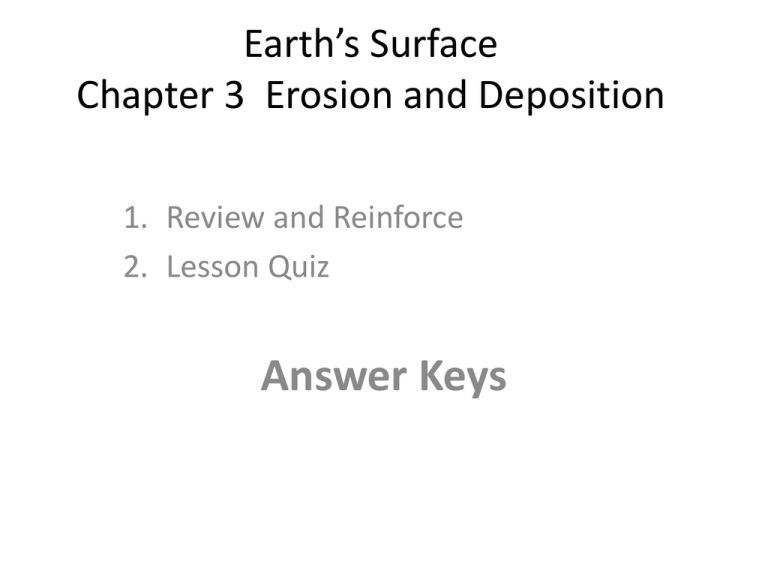
Earth’s Surface Chapter 3 Erosion and Deposition 1. Review and Reinforce 2. Lesson Quiz Answer Keys Lesson 1 Mass Movement Review and Reinforce Worksheet • • • • • • • • • • • • • • 1. mudslide 2. creep 3. landslide 4. mudslide 5. creep 6. slump 7. landslide 8. Gravity causes mass movement. 9. Weathering and erosion produce and move sediment, wearing down the land. The agents of erosion also deposit sediment. Deposition changes the shape of the land by building it up. 10. deposition 11. sediment 12. erosion 13. Mass movement 14. Gravity Lesson 1 Mass Movement Quiz 1. B 3. D 5. true 7. quickly 9. erosion 2. B 4. D 6. downhill 8. true 10. true Lesson 2 Water Erosion Review and Reinforce Worksheet • • • • • • • • • • • • • • • 1. Moving water is the major agent of the erosion that has shaped Earth’s land surface. It also builds up the surface through deposition. 2. A river erodes the land to form valleys, waterfalls, flood plains, meanders, and oxbow lakes. 3. River deposition creates alluvial fans and deltas. 4. Groundwater causes erosion through a process of chemical weathering. 5. meander 6. alluvial fan 7. stream 8. runoff 9. stalagmite 10. gully 11. karst topography 12. stalactite 13. rills 14. groundwater 15. flood plain Lesson 2 Water Erosion Quiz 1. decrease 3. true 5. true 7. D 9. A 2. true 4. delta 6. deposition 8. B 10. C Lesson 3 Glacial Erosion Review and Reinforce Worksheet. • • • • • • • • • • • • • • • • A valley glacier is a long, narrow glacier that forms when snow and ice build up high in a mountain valley. A continental glacier is a glacier that covers much of a continent or large island. 2. Glaciers form only in areas where more snow falls than melts. Snow builds up, and its weight compacts the snow, forming ice that then begins to move downhill. 3. When the depth of a glacier reaches about 30 to 40 meters, the glacier begins to move downhill because of gravity. Continental glaciers flow in all directions. 4. Glaciers erode the land by plucking and abrasion. 5. When glaciers melt, they deposit sediment. 6. Deposition 7. Erosion 8. Erosion 9. Deposition 10. Erosion 11. Erosion 12. Deposition 13. plucking 14. ice ages 15. glacier 16. till 1. Lesson 3 Glacial Erosion Quiz 1. D 3. C 5. true 7. true 9. slowly 2. A 4. B 6. true 8. continental 10. melts Lesson 4 Wave Erosion Review and Reinforce Worksheet • • 1. A sea stack forms when a sea arch collapses. 2. A wave-cut cliff forms when waves erode the base of a cliff so much that the rock above collapses. • 3. A beach forms when waves deposit sediment along a coast. • 4. A sea cave forms when waves erode a hollow area in the rock along a coast. • 5. A spit forms as a result of deposition at points where a headland or another obstacle interrupts the longshore drift. • 6. Waves erode land by impact and by abrasion. • 7. Waves eventually even out a shoreline as their energy becomes concentrated on headlands. • 8. beaches, sandbars, barrier beaches, and spits 9. longshore drift 10. Beach 11. Spit 12. headland 1. 3. 5. 7. 9. Lesson 4 Wave Erosion Quiz stack 2. true slow down 4. impact true 6. true A 8. B C 10. D Lesson 5 Wind Erosion Review and Reinforce Worksheet • • • • • • • 1. Wind causes erosion mainly by deflation, the process by which wind removes surface materials. 2. Wind picks up and moves through the air the smallest particles of sediment such as clay and silt. Slightly heavier particles, such as sand, get skipped or bounced for a short distance. Larger particles slide or roll along the ground. 3. When the wind meets an obstacle, sand the wind carries gets deposited to form a sand dune. 4. The sediments in loess deposits are clay and silt, which are finer than the sand grains in a sand dune. 5. deflation 6. loess 7. sand dune 1. 3. 5. 7. 9. Lesson 5 Wind Erosion Quiz C 2. C B 4. A true 6. true little 8. true direction 10. stronger


